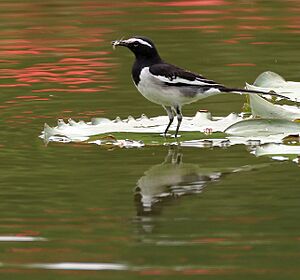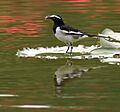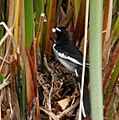White-browed wagtail facts for kids
Quick facts for kids White-browed wagtail |
|
|---|---|
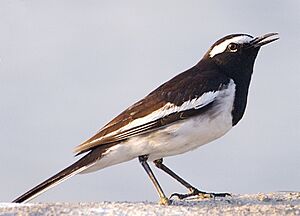 |
|
| Conservation status | |
| Scientific classification | |
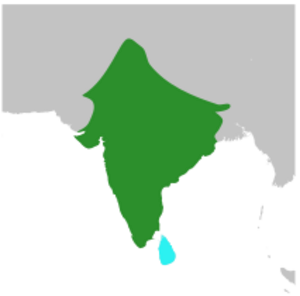 |
|
| Year-round range (green), non-breeding visitor (blue) | |
| Synonyms | |
|
Motacilla madaraspatensis lapsus |
The white-browed wagtail (Motacilla maderaspatensis), also called the large pied wagtail, is a medium-sized bird. It is the biggest member of the wagtail bird family. These birds have a clear pattern: black on top and white underneath. They also have a bright white stripe above their eyes, a white stripe on their shoulders, and white outer tail feathers.
White-browed wagtails live in South Asia. You can often find them near small bodies of water. They have learned to live in cities too, where they sometimes build their nests on rooftops. The scientific name maderaspatensis comes from the Indian city of Madras, which is now called Chennai.
Contents
What is a White-Browed Wagtail?
The white-browed wagtail is the largest type of wagtail. It grows to about 21 centimeters (8.3 inches) long. It is a slim bird with a long tail that it wags all the time. This is a common trait for all wagtails.
Its upper body, head, and chest are black. It has a white stripe above its eye and a large white bar on its wings. Unlike some other wagtails, it never has white on its forehead. The rest of its underside is white. Female wagtails have black feathers that are not as dark as the males'. Young wagtails look like females, but their black parts are more of a brown-grey color.
Where Do White-Browed Wagtails Live?
The white-browed wagtail lives in India all year round. It is only found in the Indian subcontinent. You can find it south of the Himalayas, east of the Indus River, and west of Bangladesh. It is rare in very high places. However, it has been seen in Ladakh, which is near the Tibetan plateau.
In most parts of India, it lives below 1,000 meters (3,300 feet). But in southern India, it can go up into the hills as high as 2,200 meters (7,200 feet). It is very rare in the Indus valley area and is not found in the Sind region of Pakistan. These birds like open wetlands with fresh water. They are one of the few wagtails that live well in cities. You can often see them on water tanks on top of buildings in neighborhoods.
Sometimes, they visit Sri Lanka in the winter. It seems they might be spreading to new areas recently.
How Do White-Browed Wagtails Behave?
You usually see these birds in pairs or small groups near open water. They often call out, especially in the mornings. Like other wagtails, they are very active. They will sit on the ground, on wires, or on buildings. Their song is long and loud, with many different sounds. Their usual call sounds like a wheezy "wheech."
They can fly quite fast for long distances. They fly with a bouncing motion, dipping and rising. They have been seen flying at about 40 kilometers per hour (25 miles per hour).
Reproduction and Life Cycle
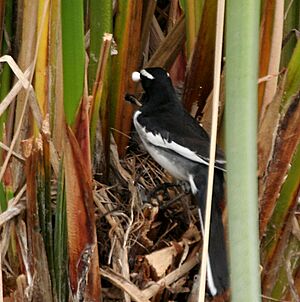
The breeding season for white-browed wagtails is from March to October. In southern India, they start nesting when river levels go down and continue until the Monsoon rains begin. During courtship, the male bird flies into the air with one wing beat. He sings and glides down with his legs dangling and feathers puffed up. When he lands, the male raises his tail high and holds his wings up over his back. He wiggles the tip of his tail stiffly while walking around the female. The female responds by crouching down and shivering her wings, as if asking for food.
They build a cup-shaped nest on the ground or on rocks. They often choose a hole, a ledge, or a mud bank. The nest is always close to water. They also use man-made places like bridges and rooftops. Nests have even been found on ferries that are used regularly! The nest is made of grass, roots, algae, and other materials. The center of the nest is a neat cup lined with hair. They usually lay four eggs, but sometimes three to five.
What Do White-Browed Wagtails Eat?
Like other wagtails, these birds eat insects. Baby wagtails are mainly fed grasshoppers, caterpillars, and spiders. They also eat certain types of beetles and bugs. Since they live in cities, they have learned to find water on rooftops. This water often comes from overflowing storage tanks.
White-Browed Wagtails in Culture
In older times in India, people sometimes kept white-browed wagtails as pet birds. They were loved for their beautiful singing. The local name for the bird, khanjan, is used in a phrase "khanjan-eyed." This phrase describes someone with beautiful eyes. The Khanjan bird was thought to be sacred and a good sign in India. People believed it had a mark of Vishnu's shaligram on its chest. There are many old beliefs about what the bird's actions or where it sat could predict for the future. Another local name for wagtails in India is dhobin, which means "washerwoman."
Images for kids
-
White-browed wagtail at nest in Hyderabad, India



